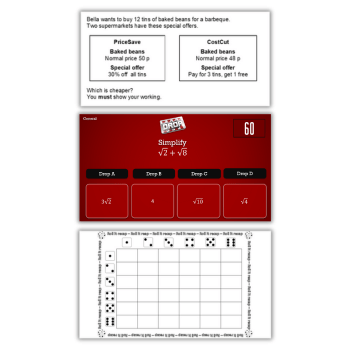Teach LCM and HCF so students don’t mix up their factors and multiples in their maths GCSE

LCM and HCF…or is that LCF and HCM? Help pupils wrap their heads around this commonly confused area of the KS4 curriculum

- by Julia Smith

‘Lowest common multiple’ and ‘highest common factor’ – two vital skills for pupils to ‘master’. Although I am fearful of using that particular term; in part because it has become overused, but also because too few people truly understand what it means and grasp its connotations.
(If you want/need to fully understand ‘maths mastery’ look no further than Mark McCourt who is the veritable Yoda on such matters. But I have gone off on a tangent, and not in any geometric sense.)
The problem is, however, that LCM and HCF is one of those mixed muddles often referred to in Chief Examiners reports, thanks to students showing confusion between “factor” and “multiple”.
It’s common for them to mix up LCM and HCF, with very few demonstrating a full understanding.
Being able to use both terms forms the basis of skills such as adding and subtracting fractions which, funnily enough, is also an area commonly answered badly in final assessments.
So why are these two terms so obtuse (again, no geometric pun intended)? Is it because they are two acronyms used together? Could a better approach be to keep them acres apart in a scheme of work? Is it because times tables knowledge is sadly lacking? Should we be encouraging copious amounts of fluency work so that they eventually ‘get it’?
Let’s consider the language.
LCM:
- Lowest – no ambiguity with that
- Common – shared by
- Multiple – multiply, multiples…a number that may be divided by another a certain number of times without a remainder
HCF:
- Highest – fine
- Common – see above
- Factor – a number or quantity that when multiplied with another produces a given number or expression
Seems straightforward, yet put them together and suddenly students get everything jumbled up. It’s on a par with the Chief Examiner’s other favourite mix-ups such as mean, median and mode; and area and perimeter.
So how can we present this to students in a way that is easier for them to comprehend? Here, I bow down here to the Jedi Knights of teaching approaches… Jo Morgan and Ed Southall.
Typically there are listing strategies and Venn diagram approaches, or an approach that combines each of these two. And with Venn diagrams making an appearance in the new big, fat, wide GCSE maths curriculum then perhaps this is a good opportunity to work the two skills efficiently together.
Trending
A good place to start is try to consider the language further, and in doing so we could do worse than adopt a word connection approach such as the one suggested by Chalkface, linking ‘factors’ and ‘factories’, and ‘multiples’ with ‘multiple packs’.
Or, we could try the Blue Peter approach using Rainbow factor methods, or a Euclidian Algorithm which may impress the parents, or there is the Indian method. All of which are beautifully demonstrated by Jo, Little Miss Resourceaholic herself, here.
Personally, I try to link any maths skill with a hook for relevance, and have 101 such hooks here for your delectation and delight.
I asked Twitter for some advice for this. Try it…they’re a very helpful bunch of maths educators in the Twitterverse’s virtual staffroom – it’s like a real staffroom, but without the cake.
And as with any real staffroom there are grumpy teachers, a few sarcastic ones, a few rudies who are to be ignored and sent to Coventry, but it is quite simply the best staffroom ever. Sorry, I’ve gone off again.
One thing that raised its ugly head when I approached Twitter about LCM and HCF – context. And this significantly polarises people. Suggestions flowed about buses leaving a depot and meeting up again, and a clip from Father of the Bride was even offered.
Yet others vehemently espouse that context is irrelevant and we should deliver these as an element of mathematical beauty in its own right.
Andrew Blair of @inquirymaths fame recommends an inquiry-based approach using a statement to be proven or disproven, which you can find here.
In any case, I’m not sure that I have “mastered” LCM and HCF myself now from a teaching point of view. But I do now have a few more tools in my toolbox which I can quickdraw and use with students at various times.
Julia Smith is Chair of Governors at Writtle University College, a teacher trainer and a maths author. Follow her on Twitter at @tessmaths. Browse our list of GCSE maths games.







